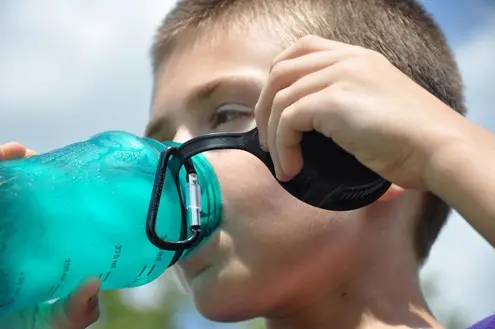On average, a person excretes 2.5-3 liters of water per day through urine, stool, breathing and skin. However, the body must have a balanced water balance, and to cover these losses, it must take in water. About one third of a liter of “new” water per day is created in the body as a result of metabolic activity, we take in about 700 ml of food-related water.
This means that the rest (approx. 1.7 liters) must be delivered to the body directly in the form of fluids. Every day for the rest of your life. Let's not forget that through physical exercise we eliminate over 3 liters of water. Even this loss must be adequately compensated. The quality of these fluids and their constant intake in the right amount is an important condition for maintaining health, mental well-being and work performance.
Why should we drink?
The appropriate amount of fluids not only ensures metabolism and good kidney function, i.e. the excretion of harmful substances produced in the body. It also enables the full functioning of literally all other organs, physical and mental functions, and supports the proper appearance of the skin.
Conversely, lack of water in the body (so-called dehydration) causes both acute and chronic problems. Acute symptoms of mild dehydration include headaches, fatigue and malaise, decreased physical and mental performance, including decreased concentration. A fluid loss of 2% of body weight equates to a loss of up to 20% of performance. This reduces children's ability to attend classes, which may adversely affect their academic performance.
Risk of dehydration
Even with 5% dehydration there is a risk of overheating, circulatory failure and shock. A small but long-term lack of fluids, which we often do not even notice in our everyday rush, can lead to serious health disorders. In addition to recurring headaches or constipation, kidney dysfunction and the formation of kidney and urinary stones may occur.
Dehydration also increases the risk of urinary tract infections, appendicitis, certain types of cancer (e.g. rectal and bladder), and cardiovascular disease.
Moreover, it is assumed that a number of other so-called lifestyle diseases is also the result of an incorrect lifestyle, including lack of fluids, or that some lifestyle diseases are either the first symptom or the result of permanent mild dehydration – these are back pain, gastric and duodenal ulcers, hypertension… .
How much water to drink?
The need for fluids is a strictly individual matter, which depends on many external and internal factors – e.g. body weight, age and gender, composition and amount of food (water, salt, protein and calorie content), physical activity, temperature and humidity of the environment, in including air flow, type of clothing and body temperature, current health condition, body hydration, etc.
Individual water needs
Each person has his or her own optimal need for free fluids, which also changes over time. This requirement can vary from less than one liter per day (in a sedentary person who consumes mainly low-salt plant, grain and legume foods) to several liters per day (in a person consuming an excessively salty or sweet low-salt diet ). The increased demand for water is influenced by intense physical work, playing sports or moving in a hot environment.
In the case of the second category, the daily requirement may exceed five liters. Everyone must find their optimal amount of fluids!
When does desire appear?
Thirst may warn us about the need to drink, but it is worth knowing that thirst is not an early sign of the need for water, as it appears only when we are 1-2% dehydrated. In addition, the feeling of thirst decreases with age.
On the other hand, an increased feeling of thirst may also be a symptom of some diseases (e.g. diabetes) and the so-called addictive thirst which may not be a sign of fluid need.
No fluids
The risk of dehydration is greater in young children, whose volume of total body water is low and normal daily losses constitute a significant proportion of it, and in older people, whose volume of total water also decreases, the ability of the kidney to reabsorb water deteriorates and the feeling of desire is weakened.
When looking for individual fluid needs, we can rely on a few basic symptoms. In addition to the feeling of thirst, symptoms of lack of fluids include dry mouth, dry lips and tongue, a small amount of dark yellow urine, tendency to constipation, hiccups when eating, tightness in the abdominal area or dry skin.
Excess fluids
On the contrary, symptoms of excess fluids include: frequent urination, especially at night, sweating at rest under normal temperature conditions, and clammy hands or feet.
Although a lack of fluids is associated with several dangers, it must be said that even a constant excess of fluids – i.e. drinking much more fluids than the body needs – is not healthy for the body.
What should you drink?
Although the healthiest drink is pure water, you can safely choose a more varied drink composition. However, it is necessary to give preference to appropriate drinks and limit the consumption of inappropriate ones, and to carefully handle these drinks, which may be conditionally suitable or inappropriate depending on how much and how often we drink them.
Appropriate drinks
Pure water is most suitable for constant drinking by people regardless of age or health – drinking filtered tap water or bottled, spring and weakly mineralized natural mineral water without carbon dioxide. This water can be consumed without limiting the amount in proportion to the body's needs. However, filtered, chlorine-free water with a pH of 7-7.5 is the best.
Suitable drinks also include fruit and vegetable juices diluted with water, unsweetened and not too strong teas (especially green ones) or roasted grain drinks. Herbal teas, unless it is for treatment, should not be drunk too often and it is advisable to change them.
Inappropriate drinks
Drinks that should be avoided or consumed very rarely include various “soft drinks”: lemonades, cola drinks, flavored mineral waters, energy drinks, nectars, etc.
The reason is sugar, which only increases the feeling of thirst and its “empty calories”; also artificial sweeteners, some of which increase appetite, or carbon dioxide, which together with organic acids (flavor substances) damages tooth enamel and has other disadvantages mentioned above.
Be careful with caffeine
The caffeine contained in cola drinks has a diuretic effect (it increases the production of urine, thanks to which more fluid is removed from the body than should be obtained after drinking the drink). It is also a mildly addictive substance that leads to hyperactivity in children. Phosphoric acid, which is also an ingredient in cola drinks, likely increases the risk of osteoporosis.
Coffee, black tea (caffeine) and alcoholic beverages are not part of the drinking regimen (they are not included in the required daily amount of fluids), they can only be a flavor supplement to the diet. They should definitely be used in moderation. Even a healthy adult should not drink more than 0.5 liters of beer or 0.2 liters of wine a day. Coffee should be washed down with a glass of clean water.
How to hydrate properly?
For “healthy” hydration, not only fluid intake and its composition are important, but also the composition of the diet.
You should drink throughout the day, starting in the morning (a cup of tea or coffee is not enough to compensate for overnight water losses). Man is not a camel to drink his supply once a day. It is necessary to regulate fluid consumption in accordance with the current load and need.
The best liquid for hot weather is plain water or lemon and mint flavored water. Sweet and cold drinks increase the feeling of thirst.
Water reaction for daily consumption it should not be sour, but slightly alkaline.


